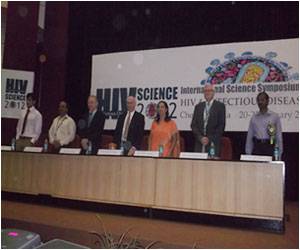While a part of the scientific community continues to chase the elusive HIV vaccine, some others are frantically stepping up ART (antiretroviral therapy) to save several lives from succumbing to AIDS and to help persons with HIV/AIDS lead a normal life.
CART 2012 (Chennai Antiretroviral therapy symposium), a two-day meet packed with scientific sessions presented by international experts involved in HIV care, discussing HIV/AIDS diagnosis, treatment and research concluded on Sunday evening in Chennai, South India. The symposium was arranged to provide the latest clinical update on HIV management, to inform practicing clinicians about current antiretroviral therapeutics and to discuss newer drugs, resistance and toxicities.Scientific Sessions on HIV/AIDS
Discussing newer methods to detect AHI (Acute HIV Infection), Dr. Charles Carpenter Professor of Medicine, Brown Medical School and Director, Lifespan/Tufts/Brown Center for AIDS Research (CFAR), NIH since 1998, presented updates on some principles of ART such as When to start? What drugs to start with? When to change? What drugs to change to? Speaking on the vast improvement in the efficacy of ART drugs in his paper Goal of Art and When to Start – New Evidence, Dr. Carpenter observed that until 2003 only patients with CD4 count less than 200 were given ART because of the toxicity of available ART drugs then. Now even patients with CD4 count below 500 are given antiretroviral therapy.
In the question hour that followed her paper on Pathogenesis and Acute Infection, Dr. Susan Little, from University of California who conducts translational research and clinical trials to understand the biology and epidemiology of HIV transmission, said that it was a big challenge to find and enroll volunteers with varying levels of HIV infection willing to participate in clinical trials.
HIV Treatment as Prevention – Breakthrough of the Year 2011
Dr. Myron S. Cohen, Professor of Medicine, Microbiology and Immunology and Public Health at the University of North Carolina said the probability of HIV transmission risk estimated at 1/1000 contacts is a serious underestimation. The actual transmission risk is much, much higher. He explained the success of the HPTN052, first major randomized clinical trials in which many countries participated. The study showed an earlier intervention of ART drugs led to a 96% reduction in HIV transmission to an uninfected partner. The HPTN052 continues and there are questions to be answered, Do these results apply to MSM (men who have sex with men) and others who have anal sex?
Dr. N. Kumaraswamy, Chief Medical Officer at YRG CARE and Organizing Chair of CART 2012 said, “The Chennai ART symposium has successfully created a venue for physicians involved in HIV care and for research experts involved in HIV drug discovery to meet and exchange ideas on the efficacy of antiretroviral therapy.”
The current economic upheaval all over the world is pushing up costs and making HIV medicine less affordable to sufferers. Medical experts at the symposium agreed that it was a major challenge to translate science into opportunities for prevention and treatment. With limited funding it was important to prioritize expenditure in HIV research, prevention and treatment. Currently two thirds is spent on HIV/AIDS prevention and one third on treatment. In India 90% of the funding comes from public sector and 10% from private funding.
We can treat people with HIV/AIDS effectively with very few side effects if medicines cost less and if patients strictly adhere to the drug regimen. The virulence of HIV and the killer nature of the AIDS epidemic require international health experts and researchers to work together on a war footing to eliminate the disease, and until that happens, to devise newer means to treat HIV and prevent HIV transmission.
Source-Medindia










